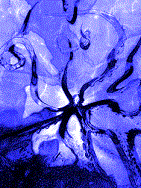COMING HOME | Louis Rakovich.
Read the story @ Bartleby Snopes.
SPOILERS BELOW!
Yes, today’s piece will most definitely include spoilers, so if you haven’t gone over to Bartleby Snopes to check out this piece, “Coming Home” by Louis Rakovich, I suggest you do so now.
This story is a marvelous little slice of sci-fi that manages to be both touching and menacing at once. But mostly menacing.
The premise of this story is straightforward, but the manner in which the narrative unfolds–the way the truth is unveiled by our narrator(s)–is rather complex. I was rather disoriented when I first began reading. Likely most people will be, since the narrator(s), let’s call them the “We-creature,” starts out extremely disoriented, fuzzy; this We-creature’s “memory” of language and other things is impaired, so it doesn’t have the vocabulary to explain what’s going on much of the time. This piece takes the challenge of defamiliarization to heart, transforming a guy’s life into a strange, mysterious world.
This piece is about a young man who falls into the ocean (we surmise, though I guess he might have been “drawn” there), his body taken by some monstrous sea creature that implants its offspring within the young man’s body. The offspring take over the body, reanimate it as a vessel for their own (as yet indeterminate) purposes.
So, the movie Alien is essentially relocated to the ocean’s depths. If space is the final frontier, oceanic depths are a close second.
The story’s conflict–from the We-creature’s point of view, anyway–is one of confusion, disorientation, loss. The story’s plot is rooted in and driven by the act of discovery. So the emotional/personal transformation that occurs for our We-character is one of self-identification. Sort of. Since the We-creature isn’t actually the owner of this discovered identity but rather the hijacker of this person’s life and selfhood, this story proves quite menacing. The culmination of the story occurs when the act of identification (really: body-theft) has reached a major turning point: the We-creature identifies the host-body’s mother as its own.
Consider this passage from the end of the story:
We sit back on the swing.Jack’s mother hands us the basket before sitting beside us.
Above us white dots are shining on a boundless black slate. We know that this is outer space, and we don’t know whether we know it because of us or because of Jack Altman. We put our head on Mother’s shoulder.
Naming is a very powerful tool for the writer. The name that one character associates with another can connote a great deal about the former. Consider if a character refers to his maternal parent as “Mom.” Now consider if this same parent were called “Mother” instead. See what I mean? This variation may not tell us much about the parent, but it certainly informs the younger character’s identity and mentality.
Such is the case in the passage quoted above. From one paragraph to the next, Jack’s mother goes from being called “Jack’s Mother” to simply “Mother.” Ordinarily, the term Mother is a benign if somewhat formal term. But Mother in this instance signals to the reader that the We-creature, the “hatchlings” or whatever was planted in Jack’s body to incubate and take over Jack’s life, have claimed Jack’s mother as their own. This is an invasion, a theft.
Pretty creepy.
Many authors, particularly of short stories, suggest the most effective endings are at once closed- and open-ended–resolving one emotional or plot process while also creating a whole new set of possibilities for the story’s continuation. Which is to say, the story could continue, but it doesn’t need to.
That’s what the author does here. The We-creature achieves an emotional shift–a pivotal step in its assimilation into this young man’s life. On an emotional level (such as it is, considering the protagonist is technically the spawn of a horrifying sea monster or alien), the story achieves closure. On the other hand, the fact of this We-creature’s invasion of the young man’s body and life leaves many questions unanswered: Why does the sea-bound Mother inject her spawn into foreign bodies? What will these spawn do now that they’re moving around in a human form?
Perhaps most frighteningly, what does the creatures’ intergenerational passage from sea to land imply for the human race at large?
This does not bode well for humanity.
